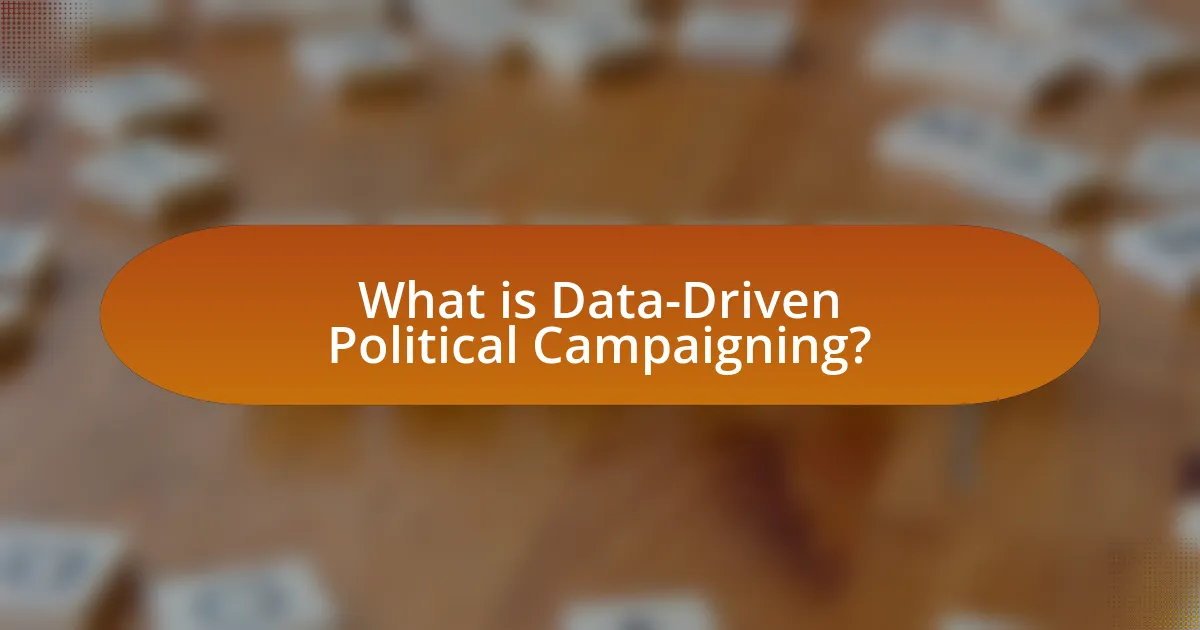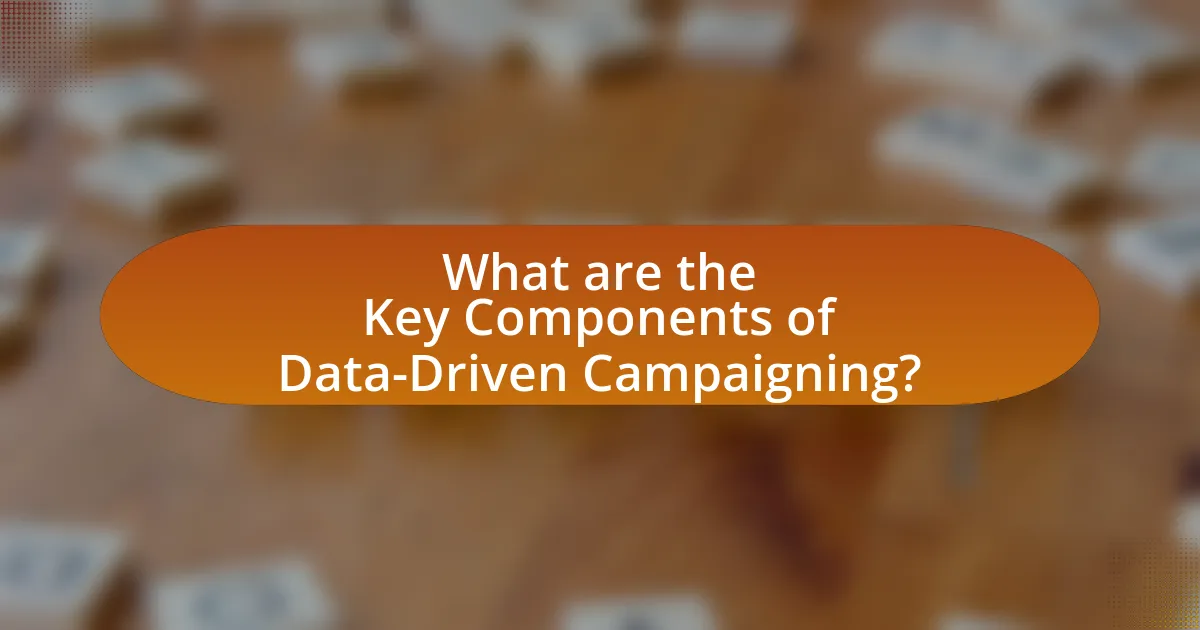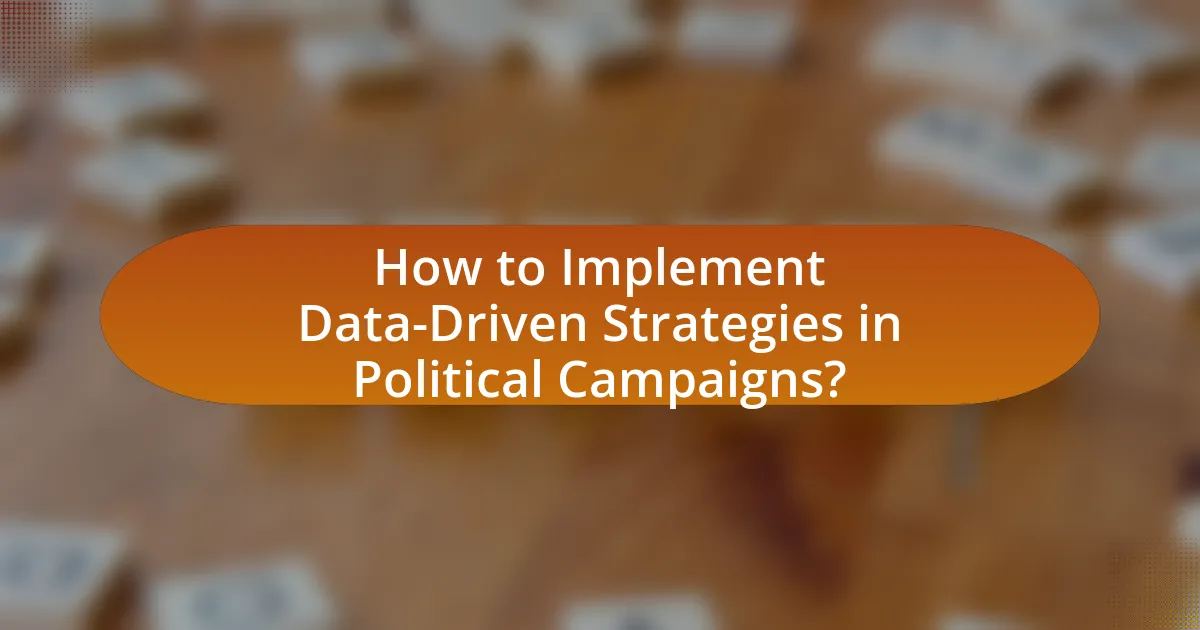Data-driven political campaigning refers to the strategic use of data analytics to enhance campaign decisions and strategies. This approach involves collecting and analyzing various types of voter data, including demographics, voting history, and social media engagement, to create targeted messaging and optimize outreach efforts. Key components of this methodology include data collection, analysis, targeted messaging, and performance measurement, which collectively improve voter engagement and resource allocation. The article also addresses the ethical considerations surrounding data usage, the importance of compliance with regulations, and best practices for leveraging data effectively in political campaigns.

What is Data-Driven Political Campaigning?
Data-driven political campaigning is the strategic use of data analytics to inform and optimize campaign decisions and strategies. This approach involves collecting and analyzing voter data, demographic information, and behavioral patterns to tailor messages and outreach efforts effectively. For instance, a study by the Pew Research Center found that campaigns utilizing data analytics can increase voter engagement by up to 20%, demonstrating the tangible impact of data-driven strategies on electoral outcomes.
How does data influence political strategies?
Data significantly influences political strategies by enabling targeted messaging and voter segmentation. Political campaigns utilize data analytics to identify key demographics, preferences, and behaviors of voters, allowing for tailored communication that resonates with specific groups. For instance, during the 2012 U.S. presidential election, the Obama campaign effectively used data to analyze voter behavior and preferences, leading to a more personalized outreach strategy that contributed to their electoral success. This data-driven approach not only enhances voter engagement but also optimizes resource allocation, ensuring that campaign efforts are focused on the most impactful areas.
What types of data are most relevant in political campaigning?
The types of data most relevant in political campaigning include voter demographics, voting history, public opinion polls, social media engagement metrics, and campaign finance data. Voter demographics provide insights into the characteristics of the electorate, such as age, gender, and ethnicity, which help tailor campaign messages. Voting history reveals patterns of past electoral behavior, allowing campaigns to identify likely supporters. Public opinion polls gauge the electorate’s views on key issues and candidate favorability, guiding strategic decisions. Social media engagement metrics track interactions and sentiment, informing outreach strategies. Campaign finance data discloses funding sources and expenditure patterns, which are crucial for compliance and strategic resource allocation. These data types collectively enhance the effectiveness of political campaigns by enabling targeted messaging and informed decision-making.
How is data collected and analyzed for campaigns?
Data for campaigns is collected through various methods, including surveys, social media analytics, and voter databases. These methods allow campaign teams to gather quantitative and qualitative information about voter preferences, behaviors, and demographics. For instance, surveys can yield insights into voter opinions, while social media analytics can track engagement and sentiment around campaign messages.
Once collected, data is analyzed using statistical tools and software to identify trends, segment audiences, and measure campaign effectiveness. Techniques such as regression analysis and data visualization help campaign strategists understand the impact of their efforts and adjust strategies accordingly. According to a study by the Pew Research Center, 60% of political campaigns utilize data analytics to inform their strategies, demonstrating the critical role of data in modern campaigning.
Why is leveraging data important for political campaigns?
Leveraging data is crucial for political campaigns because it enables targeted messaging and strategic decision-making. By analyzing voter demographics, preferences, and behaviors, campaigns can tailor their outreach efforts to resonate with specific segments of the electorate. For instance, a study by the Pew Research Center found that data-driven campaigns can increase voter engagement by up to 20%, demonstrating the effectiveness of personalized communication. Additionally, data analytics allows campaigns to allocate resources efficiently, optimizing ad spending and maximizing impact. This strategic use of data ultimately enhances a campaign’s ability to connect with voters and drive electoral success.
What advantages does data provide over traditional campaigning methods?
Data provides significant advantages over traditional campaigning methods by enabling targeted outreach and personalized messaging. Unlike traditional methods that often rely on broad demographics, data analytics allows campaigns to identify specific voter segments and tailor their strategies accordingly. For instance, campaigns can analyze voter behavior, preferences, and past voting patterns to create customized messages that resonate with individual voters. This targeted approach has been shown to increase engagement and conversion rates; a study by the Pew Research Center found that personalized political messages can lead to a 20% increase in voter turnout compared to generic outreach. Additionally, data-driven campaigns can optimize resource allocation by focusing efforts on high-impact areas, ultimately leading to more efficient use of campaign budgets.
How can data improve voter engagement and outreach?
Data can significantly improve voter engagement and outreach by enabling targeted communication strategies. By analyzing demographic information, voting history, and social media interactions, political campaigns can identify specific voter segments and tailor their messages accordingly. For instance, a study by the Pew Research Center found that personalized outreach efforts, such as targeted emails and social media ads, can increase voter turnout by up to 20%. Additionally, data analytics can help campaigns optimize their resource allocation, ensuring that outreach efforts are focused on areas with the highest potential for impact. This data-driven approach not only enhances engagement but also fosters a more informed electorate.

What are the Key Components of Data-Driven Campaigning?
The key components of data-driven campaigning include data collection, data analysis, targeted messaging, and performance measurement. Data collection involves gathering information from various sources such as voter databases, social media, and surveys to understand the electorate. Data analysis transforms this information into actionable insights, identifying trends and voter preferences. Targeted messaging utilizes these insights to craft personalized communications that resonate with specific voter segments. Performance measurement assesses the effectiveness of campaign strategies through metrics like engagement rates and conversion rates, allowing for real-time adjustments. These components collectively enhance the campaign’s ability to connect with voters and optimize resource allocation.
How do voter demographics impact campaign strategies?
Voter demographics significantly impact campaign strategies by influencing messaging, resource allocation, and outreach efforts. Campaigns analyze demographic data, such as age, race, gender, and socioeconomic status, to tailor their messages to resonate with specific voter groups. For instance, younger voters may prioritize issues like climate change and social justice, prompting campaigns to focus on these topics in their communications. Additionally, campaigns allocate resources strategically; for example, they may invest more in areas with higher concentrations of target demographics, as seen in the 2020 U.S. presidential election where both parties concentrated efforts in swing states with diverse populations. This targeted approach enhances voter engagement and increases the likelihood of mobilizing support.
What demographic data should campaigns focus on?
Campaigns should focus on demographic data such as age, gender, income level, education, ethnicity, and geographic location. These factors significantly influence voter behavior and preferences, allowing campaigns to tailor their messaging and outreach strategies effectively. For instance, according to the U.S. Census Bureau, age demographics show that younger voters (ages 18-29) tend to lean more towards progressive policies, while older voters (ages 65 and above) often prioritize issues like healthcare and social security. Understanding these distinctions enables campaigns to allocate resources efficiently and engage with specific voter segments more meaningfully.
How can demographic insights shape messaging?
Demographic insights can shape messaging by allowing political campaigns to tailor their communication strategies to specific audience segments. By analyzing factors such as age, gender, income, education, and geographic location, campaigns can create messages that resonate more deeply with targeted voter groups. For instance, a study by the Pew Research Center found that younger voters prioritize climate change, while older voters may focus on healthcare issues. This understanding enables campaigns to craft messages that address the unique concerns and values of each demographic, ultimately enhancing engagement and increasing the likelihood of voter support.
What role does social media play in data collection?
Social media serves as a crucial tool for data collection by providing vast amounts of user-generated content and engagement metrics. Platforms like Facebook, Twitter, and Instagram allow political campaigns to gather demographic information, track user interactions, and analyze sentiment through likes, shares, and comments. According to a 2020 study by Pew Research Center, 69% of adults in the U.S. use social media, making it a rich source for understanding voter preferences and behaviors. This data enables campaigns to tailor their messaging and outreach strategies effectively, enhancing voter engagement and targeting efforts.
How can campaigns utilize social media analytics?
Campaigns can utilize social media analytics to gain insights into voter behavior and preferences, allowing for targeted messaging and strategy adjustments. By analyzing engagement metrics such as likes, shares, and comments, campaigns can identify which content resonates most with their audience. For instance, a study by the Pew Research Center found that 69% of adults in the U.S. use social media, highlighting its significance as a platform for reaching potential voters. Additionally, tools like sentiment analysis can help campaigns understand public opinion on key issues, enabling them to tailor their outreach effectively.
What are the best practices for engaging voters on social platforms?
The best practices for engaging voters on social platforms include creating targeted content, utilizing data analytics, and fostering two-way communication. Targeted content ensures that messages resonate with specific demographics, increasing relevance and engagement. Data analytics allows campaigns to track voter behavior and preferences, enabling the optimization of outreach strategies. Fostering two-way communication encourages voter interaction, making them feel valued and heard, which can enhance loyalty and turnout. According to a study by the Pew Research Center, 69% of adults in the U.S. use social media, highlighting the importance of these platforms in reaching and engaging voters effectively.

How to Implement Data-Driven Strategies in Political Campaigns?
To implement data-driven strategies in political campaigns, campaigns should first collect and analyze voter data to identify key demographics and preferences. This involves utilizing tools like voter databases, social media analytics, and surveys to gather insights on voter behavior and sentiment. For instance, the 2020 U.S. presidential campaign effectively used data analytics to target specific voter segments, resulting in a more tailored messaging approach that increased voter engagement. By continuously monitoring and adjusting strategies based on real-time data, campaigns can optimize their outreach efforts and improve overall effectiveness.
What tools and technologies are available for data analysis?
Data analysis tools and technologies include software and platforms such as Python, R, SQL, Tableau, and Microsoft Excel. Python and R are programming languages widely used for statistical analysis and data visualization, offering libraries like Pandas and ggplot2 that facilitate complex data manipulation and graphical representation. SQL is essential for managing and querying relational databases, enabling efficient data retrieval. Tableau provides powerful data visualization capabilities, allowing users to create interactive dashboards. Microsoft Excel remains a fundamental tool for data analysis due to its accessibility and functionality for basic statistical operations and data organization. These tools are validated by their widespread adoption in various industries, including political campaigning, where data-driven decisions are crucial for targeting and engagement strategies.
Which software solutions are most effective for campaign data management?
The most effective software solutions for campaign data management include NGP VAN, NationBuilder, and Salesforce. NGP VAN is widely used in political campaigns for its comprehensive tools that manage voter data, fundraising, and outreach, making it a preferred choice for Democratic campaigns. NationBuilder offers a robust platform for organizing supporters and managing communications, which is beneficial for grassroots campaigns. Salesforce, while not exclusively for political campaigns, provides customizable solutions that can integrate various data sources, allowing for effective campaign management and analytics. These platforms are validated by their extensive use in successful political campaigns, demonstrating their effectiveness in managing campaign data efficiently.
How can campaigns integrate various data sources for better insights?
Campaigns can integrate various data sources for better insights by employing data management platforms that consolidate information from social media, voter databases, and analytics tools. This integration allows campaigns to create a comprehensive view of voter behavior and preferences, enhancing targeting strategies. For instance, using platforms like Salesforce or HubSpot enables the aggregation of data from multiple channels, which can lead to more informed decision-making. Research indicates that campaigns utilizing integrated data sources can increase engagement rates by up to 30%, demonstrating the effectiveness of this approach in political campaigning.
What are the ethical considerations in data usage for campaigns?
Ethical considerations in data usage for campaigns include informed consent, data privacy, and transparency. Informed consent requires that individuals understand how their data will be used before providing it, ensuring they have the right to opt-out. Data privacy involves safeguarding personal information from unauthorized access and misuse, which is critical given that 79% of Americans express concern over how their data is used. Transparency mandates that campaigns disclose their data practices, fostering trust and accountability. These considerations are essential to maintain ethical standards and comply with regulations such as the General Data Protection Regulation (GDPR), which emphasizes the importance of protecting individuals’ data rights.
How can campaigns ensure data privacy and security?
Campaigns can ensure data privacy and security by implementing robust data protection measures, including encryption, access controls, and compliance with regulations such as GDPR. Encryption protects sensitive data by converting it into a secure format, making it unreadable without the correct decryption key. Access controls limit data access to authorized personnel only, reducing the risk of unauthorized data breaches. Compliance with regulations like GDPR mandates that campaigns follow strict guidelines on data collection, storage, and processing, ensuring that individuals’ privacy rights are respected. These practices collectively enhance the security of campaign data and build trust with constituents.
What regulations must campaigns comply with regarding data usage?
Campaigns must comply with regulations such as the General Data Protection Regulation (GDPR) in Europe and the California Consumer Privacy Act (CCPA) in the United States regarding data usage. These regulations mandate that campaigns obtain explicit consent from individuals before collecting their personal data, ensure transparency about how data will be used, and provide individuals with rights to access, modify, or delete their data. For instance, GDPR imposes strict penalties for non-compliance, emphasizing the importance of data protection and privacy in political campaigning.
What are the best practices for leveraging data in political campaigning?
The best practices for leveraging data in political campaigning include utilizing targeted voter segmentation, employing data analytics for strategic decision-making, and continuously monitoring campaign performance. Targeted voter segmentation allows campaigns to identify and engage specific demographics, enhancing message relevance and outreach effectiveness. Data analytics enables campaigns to assess voter behavior and preferences, guiding resource allocation and messaging strategies. Continuous performance monitoring, through metrics such as voter engagement and conversion rates, ensures campaigns can adapt in real-time to maximize impact. These practices are supported by studies showing that data-driven campaigns can increase voter turnout by up to 20%, demonstrating the effectiveness of strategic data use in political contexts.
How can campaigns continuously improve their data strategies?
Campaigns can continuously improve their data strategies by implementing iterative testing and analysis of data-driven decisions. This involves regularly assessing the effectiveness of various campaign tactics through A/B testing, which allows campaigns to identify what resonates best with their target audience. For instance, a study by the American Association of Political Consultants found that campaigns utilizing data analytics to refine their messaging saw a 20% increase in voter engagement compared to those that did not. Additionally, leveraging real-time data analytics tools enables campaigns to adapt their strategies promptly based on current trends and voter feedback, ensuring that their approaches remain relevant and effective.
What common pitfalls should campaigns avoid when using data?
Campaigns should avoid common pitfalls such as relying on incomplete data, misinterpreting data trends, and neglecting data privacy concerns. Incomplete data can lead to misguided strategies, as decisions based on insufficient information often result in ineffective targeting and messaging. Misinterpreting data trends can cause campaigns to draw incorrect conclusions, leading to strategies that do not resonate with the electorate. Additionally, neglecting data privacy can damage a campaign’s reputation and trustworthiness, as breaches or misuse of personal information can alienate potential voters. These pitfalls can significantly undermine the effectiveness of data-driven strategies in political campaigning.


